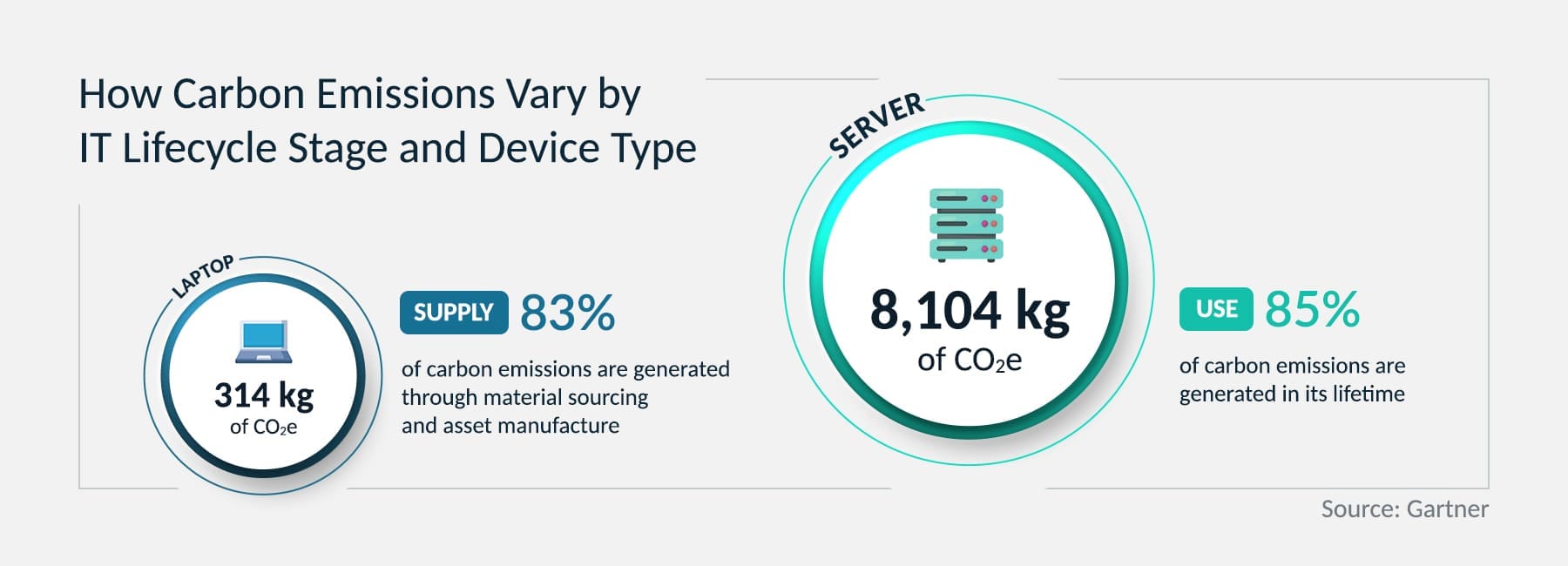This article explains the concept of Sustainable IT, highlights the key emission sources and provides a narrative around the green IT initiatives that we see organisations focussing on within their internal IT operations in 2024 – many of which are easy to implement.
This year Sustainable IT is set to be recognised as a priority area within the overall corporate sustainability agenda. There is now a growing awareness and concern about the carbon footprint of enterprise IT which is increasing at a more rapid rate than other sources of carbon emissions. In 2024, organisations also become a step nearer to stringent compliance regulations with the introduction of the EU Corporate Sustainability Reporting Directive (CSRD) and other directives many of which encompass technology operations.
Contents
What is sustainable or green IT?
Sustainable IT refers to the practice of incorporating environmentally and socially responsible principles into the design, use, and disposal of IT hardware and software and the mapping of the accompanying business processes. According to Capgemini the field of Sustainable IT can also encompass activities such as the responsible mining of rare metals used to manufacture the hardware, water conservation and the application of circular economy principles across the technology lifecycle.[1]
How IT contributes to the global carbon footprint
In 2020, It was estimated that the information communication technology (ICT) sector share of global GHG emissions to be 1.8-2.8%[2] which is similar to the levels of emissions from the aviation sector. Research has been undertaken about the sources of the Greenhouse Gas (GHG) released from the technology lifecycle stages – from supply, use to end-of-life (disposal) and found that emissions vary at each lifecycle stage by type of IT equipment.
Against the backdrop of these staggering statistic according to Capgemini only 43% of executives were aware of their own company’s carbon footprint.[3]

6 Sustainable IT initiatives
Initiatives within Green Computing and Sustainable IT practices aim to mitigate the environmental impact of IT operations. Reducing IT emissions can be achieved by changing IT at a strategic level such as improving energy efficiency, adopting renewable energy sources and optimising data centre design. Below are six sustainable practices you can implement in the short term such as promoting responsible e-waste management, and encouraging sustainable practices in the IT industry.
Extending the life of end-user devices or BYOD
According to McKinsey overall 50 to 60 percent of emissions[4] related to end-user devices can be addressed through sourcing changes, primarily by procuring fewer devices per person or extending the life of a device. As per the earlier illustration contrary to belief, the carbon cost of producing a device is nearly equal or exceeds the carbon cost of using them. Extending the life of a device will not require any investment and will lower costs, though companies may want to evaluate the impact on employee experience.
Measure your e-waste and partner with a sustainable technology lifecycle management provider
A survey of 1,000 businesses conducted by CapGemini found that 89% of organisations recycle less than 10% of their IT hardware[5]. It is therefore hardly surprising that e-waste is the fastest-growing solid waste stream in the world, with more than 50 million metric tonnes generated globally every and levels predicted to exceed 75 million tonnes by 2030[6]. In the UK, we generate 1.5 million tonnes of e-waste every year.[7]
The IT recycling sector is undergoing a revolution in a quest to address the e-waste issue with industry leaders innovating and bringing together advanced recycling biotechnologies to extract valuable materials from electronic waste, such as precious metals from old computers and smartphones. This concept has been named “the urban mine” (see below).
When selecting an IT asset recycling partner it is important to consider the sustainability and circularity of their services besides other key factors such as the cost and data security. Do they provide recycling, reusing and refurbishment services and can they provide GHG reporting?
In 2024, more focus, measurement and research will be placed around the end-of-life of technology, understanding the GHG impact, IT lifecycle management and how the concept of the urban mine can be a reality.

The urban mine concept
The term “urban mine” typically refers to the concept of extracting valuable resources or materials from urban and industrial waste streams. It is a way of viewing the built environment as potential sources of valuable raw materials, similar to traditional mining but focused on recycling and reusing existing materials. Urban mining involves the recovery of metals, minerals, and other valuable resources from discarded electronic devices, construction waste, and other urban waste materials. It is estimated that the precious metals contained within the electronic equipment that ends up in landfills have an estimated worth of £370 million in the UK alone.*
This approach is driven by the increasing awareness of the finite nature of many resources and the environmental impact of traditional mining methods.
Efforts in urban mining often include the development of advanced recycling technologies to extract valuable materials from electronic waste, such as precious metals from old computers and smartphones. The goal is to reduce the environmental impact of mining, decrease the demand for new raw materials, and promote a more sustainable and circular economy.
Selecting data centres with renewable energy
Data centres have historically been major contributors to CO2 emissions. In 2023, they accounted for 1-1.3% of the world’s energy demand[8]. Now industry leaders such as Microsoft and Google are moving from fossil fuel to renewable energy. According to the CapGemini survey, only 17% of respondents had deployed measures to use green power. In 2024, it is likely the C-suite will be looking at every aspect of their data centre operations and reducing power consumption from moving to edge computing to switching to a green website hosting provider such as GreenGeeks.
Procure sustainable devices
More and more organisations are looking to procure refurbished devices. Traditionally refurbished devices were pre-owned, inspected, repaired and restored to a premium-like new condition. However, in the last couple of years, there has been a new mini-revolution in this market with industry players such as Framework manufacturing their own brand of laptops. There is also a change in paradigm with the global manufacturers focussing on new product development to create new 100% recyclable laptops. For example, Microsoft has pledged that the Microsoft Surface and associated packaging will be 100% recyclable by 2030.
Awareness and education of all employees
From senior executives to the entire workforce, it is really important to educate all employees on the importance and practice of sustainable IT. At a strategic level, it is key for executives to understand core Sustainable IT concepts such as how GHG is calculated, e-waste, the urban mine and the myriad of forthcoming legislation such as CSRD.
At an employee level, it is important for organisations to ensure their employees are environmentally aware and engaged and by running IT sustainability sessions to encourage employees to turn their computers off during non-working hours, put printers on standby and reduce data usage by limiting the number of emails and video streams.
It is also likely that IT Sustainability will become more integrated into the overall Corporate Sustainability framework – historically many companies have run these policies in virtual isolation.
Sustainable IT policies could become the norm
In recent years, it is commonplace to see a company’s privacy policy and terms and conditions on a website. More and more companies are starting to formulate and make public their Sustainable IT policy. These Sustainable IT policies encompass statements around energy efficiency, renewable energy, lifecycle management, awareness and education, innovation and research, sustainable procurement and stakeholder engagement. They are essentially a summation of all Sustainable IT actions.
The importance of combining short-term actions with a longer-term roadmap
According to McKinsey, CIOs who act decisively and precisely can achieve 15 to 20 percent of carbon reduction potential in the first year with minimal investment. In parallel, to all these short-term measures, it is imperative to plan for the future this long-term framework incorporates procurement policies, key metrics, and a performance management system.
The establishment of a metrics and performance management platform is key to readying organisations for all the impending legislation that requires them to measure, manage and report on their value chain impacts such as CSRD and the release of the first standards from the International Sustainability Standards Board — known as IFRS S1 and S2.
[1] (2021) Capgemini “Sustainable IT – Why its time for a Green revolution in your organization’s IT” p5
[2] ScienceDirect (2021) ‘The real climate and transformative impact of ICT: A critique of estimates, trends and regulations
[3] (2021) Cap Gemini “Sustainable IT – Why its time for a Green revolution in your organization’s IT” p10
[4] www.mckinsey.com/capabilities/mckinsey-digital/our-insights/the-green-it-revolution-a-blueprint-for-cios-to-combat-climate-change
[5] (2021) Capgemini “Sustainable IT – Why its time for a Green revolution in your organization’s IT” p5
[6] www.itu.int/en/ITU-D/Environment/Pages/Spotlight/Global-Ewaste-Monitor-2020.aspx
[7] (2020) “Electrical Waste – challenges and opportunities” Anthesis/Lancaster University
[8] (2023) IEA – Data Centres and Data Transmission Networks resource.co/article/uk-track-become-europe-s-biggest-e-waste-contributor Report by Spring
[9] www.mckinsey.com/capabilities/mckinsey-digital/our-insights/the-green-it-revolution-a-blueprint-for-cios-to-combat-climate-change




